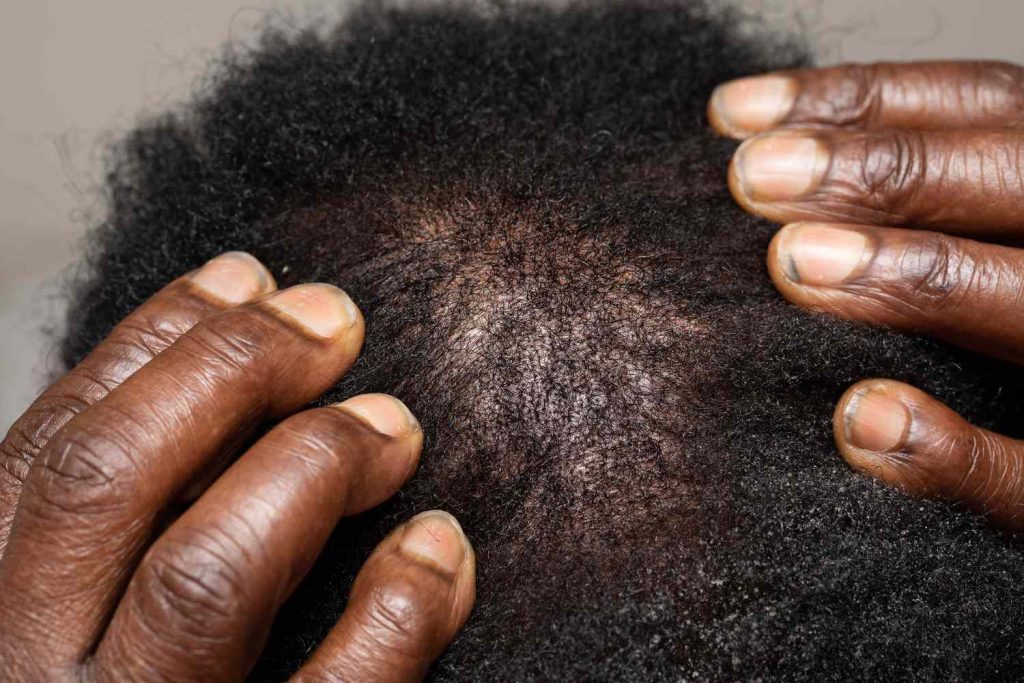Thinning hair is common and often treatable. It can affect women and men and can be caused by hormones, genetics, aging, infections, medication, autoimmune diseases, and more. Treatments to stop thinning hair are based on the cause but include supplements, medicated shampoos, prescriptions, and changes to one’s hygiene routine.
sruilk / Getty Images
What Causes Thinning Hair?
Thinning hair usually results from alopecia (hair loss). If you’ve noticed that your hair looks less full, it may be because you’re losing strands of hair.
Sometimes, thinning hair can occur without hair loss. This happens when abnormalities in the hair follicle cause your body to produce strands of hair that are thinner than usual and therefore more prone to breaking.
Whether you’re experiencing just hair thinning or hair thinning with hair loss, these causes may be at play:
- Genetics: Hereditary hair loss (thinning hair or hair loss caused by your genes) is the most common type of hair loss and can occur in people of any sex.
- Aging: Hair growth naturally slows with age.
- Hormonal changes: The postpartum period (after giving birth) and menopause (cessation of menstrual periods) are linked to temporary hair loss and thinning.
- Chronic health conditions: Thyroid disease and chronic autoimmune conditions, including alopecia and scalp psoriasis, can lead to thinning hair and hair loss.
- Infections: Scalp infections can cause thinning hair.
- Hair styles and treatments: Harsh hair treatments, like perms and relaxers, and tight hairstyles that pull your locks can lead to hair thinning or a receding hairline.
- Physical or emotional stress: Emotional stress and physical stress, like a major fever or sudden weight loss, can trigger thinning hair.
- Medications and treatments: Certain medications and medical treatments, like chemotherapy, can make you lose your hair.
- Nutrient deficiencies: Not getting enough iron, zinc, biotin, and protein can negatively affect your hair.
How to Reverse or Slow Down Thinning Hair
The best way to slow down or reverse thinning hair is to start treatment early. Treatment is most effective when it’s started soon after you notice hair loss.
Treating thinning hair will depend on the cause of your hair loss and may take some trial and error to determine. Sometimes, thinning hair will naturally return to normal. For example, hair loss after pregnancy or during menopause (the cessation of menstrual cycles) typically stops within six months to two years, and hair volume should return to normal.
If your thinning hair is caused by medications or medical treatment, you’ll likely notice better hair growth when you stop the treatment.
The following are ways to treat thinning hair:
1. Find a Board-Certified Dermatologist
A dermatologist (a medical doctor specializing in conditions of the skin, hair, and nails) can help with hair loss. A dermatologist will perform an examination of your scalp and other skin and will test the strength of your hair. They will ask about your history of hair loss and your overall health before developing a treatment plan.
2. Consider Lifestyle Changes
Oftentimes, adopting a more gentle hair routine can help slow down or reverse hair thinning. Traction alopecia is a type of hair thinning and hair loss caused by pulling your hair too tight. It can result in hair thinning at the front of the hairline.
Harsh treatments like relaxers can also damage hair, leading to hair thinning, especially if they’re done at home rather than by a professional. The hair of Black people is especially fragile and prone to this type of thinning.
These tips can help:
- Go to a profession for hair care, especially for treatments like relaxers and perms that involve harsh chemicals.
- Loosen your braids or locs, especially around the hairline.
- Opt for wider braids and locs to reduce how much they pull.
- Take occasional breaks from tight hairstyles like weaves, cornrows, or taut ponytails.
3. Medications
Medications can help with thinning hair, including:
- Rogaine (minoxidil): Topical Rogaine is an over-the-counter medication applied to the scalp to help stop hair loss and facilitate hair growth. The medication increases blood flow to the hair follicles, resulting in thicker hair and faster growth. Results take time, typically six to 12 months. You’ll have to continue using the medication to prevent more hair loss.
- Propecia (finasteride): Propecia is an oral prescription medication. It’s only approved to treat male-pattern baldness. Avodart (dutasteride) is a similar drug, but its use for hair loss is off-label, meaning it is approved by the Food and Drug Administration for a different use but not for hair loss.
- Aldactone (spironolactone): Spironolactone is an oral prescription medication that can treat hair thinning caused by female-pattern baldness.
- Oral minoxidil: Low-dose oral minoxidil is sometimes prescribed off-label for male- and female-pattern hair loss.
4. Steroid Shots
Getting injections of corticosteroids into the scalp can help hair regrow. This is especially effective for people with hair loss caused by alopecia areata. You’ll need injections every four to eight weeks to see results.
5. Laser Therapy
Some studies have shown that at-home laser treatments to stimulate the hair follicles can help reverse thinning hair. These treatments are typically done three times each week at home. They can benefit men and women, but not everyone will see results.
6. Microneedling
Microneedling for hair loss uses tiny needles to stimulate the hair follicles to grow. It can be used in conjunction with other treatments for hair loss and thinning hair, including Rogaine. The treatments can be done at home, but you should talk with your dermatologist before starting them since they could worsen hair thinning or hair loss.
7. Platelet-Rich Plasma (PRP)
Platelet-rich plasma injections use a part of your own blood to facilitate hair growth. During the procedure you have blood withdrawn, which is then run through a machine that separates it into parts. The platelet-rich fraction is then injected into your scalp.
It is usually injected monthly for three or four sessions and then maintained with an injection every four to six months.
8. Supplements
If your dermatologist believes that nutrition deficiencies are contributing to your thinning hair, they will order blood work. If deficiencies are detected, your provider may recommend supplements containing key nutrients like:
Note that supplements will only help if you have a deficiency. Taking them if you have normal levels can be harmful. Increasing your protein intake can also help.
Coping With Thinning Hair
If your thinning hair is impacting your confidence, you can use products to hide your thinning hair. A full or partial hairpiece or wig may make a difference. Sprays and concealers can also help disguise hair loss. An experienced hairdresser may also be able to help you find styles that work best for your thinning hair.
When to Ask a Provider
Talk with a healthcare provider about thinning hair anytime you’re interested in treatment. Remember, treatment is most effective when it’s started early. You should also talk with a healthcare provider about thinning hair if you have:
- Patchy or unusually-patterned hair loss
- Hair loss in your teens or early 20s
- Scalp pain, itching, rash, or inflammation
- Bald spots on the beard, eyebrows, or other areas on the body
- Unexplained weight loss or weight gain
- Fatigue
Summary
Thinning hair has many causes. It’s often triggered by genetics and can be a natural part of aging. However, hormone fluctuations, chronic disease, and infections can cause hair thinning and loss.
Sometimes, hair thinning resolves naturally, such as after pregnancy or menopause. Other times, as with hereditary hair loss, it worsens until treated. It’s best to start treatments early and work with an experienced dermatologist who can help you fight your thinning hair.
:max_bytes(150000):strip_icc()/BurchHeadshotOutdoor-215a575f7ef34c52a908676f88bd9acb.jpg)
By Kelly Burch
Burch is a New Hampshire-based health writer with a bachelor’s degree in communications from Boston University.
Thanks for your feedback!
What is your feedback?







